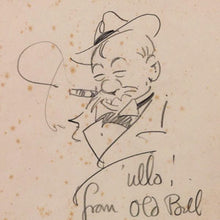‘Old Bill’, Captain Bruce Bairnfather’s Eponymous Hero, circa 1920
- Regular price
- £460
- Sale price
- £460
- Regular price
-
- Unit price
- /per
Adding product to your cart
Overall: 32cm (12.5in) x 26cm (10.2in)
Pencil on notepaper. Signed and inscribed 'Ullo! From Old Bill and Bruce Bairnsfather’, 29cm x 23cm.
'Old Bill' was an immensely popular cartoon character who personified the practical philosophy of the British private soldier in the trenches during the First World War. He was created by Captain Bruce Bairnsfather (1888-1959) and gained widespread fame through various media including a six-volume series Fragments from France published by the Bystander magazine.
Read more
Charles Bruce Bairnsfather was born in British India, the son of an army officer with musical leanings. He was educated at the United Service College, Westward Ho!, but failed the entrance exams for both Sandhurst and Woolwich. Undeterred he enlisted in the militia battalion of the Royal Warwickshire Regiment in 1905 and for a short time served in the Cheshire Regiment. In 1907 he left the army and to train as a graphic artist at the Hassall Art School. On the outbreak of war in August 1914 he was recalled to the Royal Warwickshire Regiment and, commissioned into the 1st Battalion, arrived on the Western Front in November 1914. While in to the command of a machine gun section, he witnessed the Christmas Truce of 1914, and later remarked: "It all felt most curious: here were these sausage-eating wretches, who had elected to start this infernal European fracas, and in so doing had brought us all into the same muddy pickle as themselves... There was not an atom of hate on either side that day; and yet, on our side, not for a moment was the will to war and the will to beat them relaxed."
Following the Second Battle of Ypres in April 1915 he was found to be suffering from the effects of chlorine gas, and was later caught in a shell blast causing his evacuation to England where he was diagnosed with shell shock. While recuperating in hospital, Bystander magazine, which had previously published some of his sketches of trench life, commissioned him to produce a series of weekly cartoons featuring ‘Old Bill’. Assigned to an infantry training role at home, Bairnsfather set about developing ‘Old Bill’ – the veteran Tommy with trade mark walrus moustache, balaclava and later a tin hat. Official recognition of ‘Old Bill’s’ popularity with the troops in the field resulted in Bairnsfather being transferred to the Intelligence Department and his talents being utilized for propaganda purposes in connection with the American and Italian allies. Post war he was a vociferous spokesman on behalf of those who had experienced the trenches, and was a critic of such edifices as the Menin Gate Memorial, arguing the money spent building it might be more usefully spent on helping ex-servicemen in civilian life.






